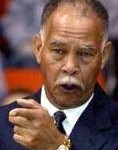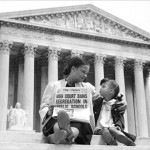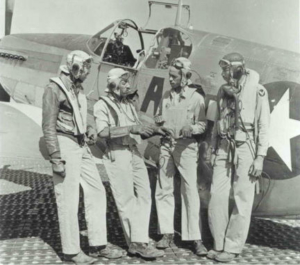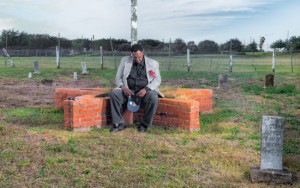How a Wave of Honest History Museums Is Changing Black Tourism
Photo: Visitor Dwayne Wilson sits in the Contemplative Court at the National Museum of African American History and Culture in Washington on Sept. 7. (Evelyn Hockstein/For the Washington Post via Getty Images)
(Slate) While 30 percent of black leisure travelers consider learning about history and local culture to be an important part of vacation, black travelers are less likely than others to spend their time visiting museums and historical sites. That shouldn’t be surprising. After all, black travelers have the same vacation goals as anyone else: relax, recharge, hopefully learn a bit along the way. But there’s a feeling of tension inherent in walking through a space knowing there’s something you aren’t being told, and working out whether and how to respond. For so long, that tension is exactly what the typical history museum has offered black visitors by peddling incomplete representations of American history. Who needs that kind of extra baggage on vacation?
Thankfully, the opening of the Legacy Museum and the associated National Memorial for Peace and Justice in Montgomery, Alabama, represents a growing wave of historical attractions aiming to look squarely at American history. A memorial and museum “dedicated to the legacy of enslaved black people, people terrorized by lynching, African Americans humiliated by racial segregation and Jim Crow, and people of color burdened with contemporary presumptions of guilt and police violence” may not be relaxing in the traditional sense—but it is refreshingly honest. The Legacy Museum and attractions like it are transforming the experience of historical tourism for black people. (more)
12th & Chicon Bus Stop Will Showcase East Austin’s African-American History
(KUT) The bus stop at the southeast corner of 12th Street and Chicon once featured vibrant plaques commemorating the history of East Austin. But the plaques have fallen into disrepair since being installed in 2003. Now, Capital Metro wants to redo the bus stop to honor the area’s African-American legacy.
Creola Shaw-Burns is a fifth-generation Austinite. She owns Shaw’s Garage, located on East 12th, and is an active member of the East 12th Street Merchants Association. She said she was excited when Cap Metro reached out to the association last November to ask for help on the bus stop redesign.
“I want to make that sure my children … I want them to know that there’s a history,” she said. “I want them to know that African-Americans were pushed to this area of town in the 1920s.” (more)
Related: View Spectrum News Austin video here.
Elwood T. Driver was Bryan officer, Tuskegee Airman
(Bryan Eagle) Col. Joseph Duckworth was a son of the South. He was born in Savannah, Georgia, and in 1940 was called to active military duty from a job in Atlanta as a commercial airline pilot with Eastern Airlines.
He took command of Bryan Field to establish an Instrumentation-Instruction School.
He’s still recognized today as the father of modern military instrument flight.
Capt. Elwood T. Driver was one of the thousands of pilots to successfully complete Duckworth’s “all-weather” instrument course. He finished the six-week program in January 1945.
His involvement and success is historically notable.
Driver was the first “colored officer”-as proclaimed by a news release from the public relations office at Bryan Field-to gain instrument rating at the Texas installation.
He was also a Tuskegee Airman. (more)
Newly Discovered Cemetery Vindicates Sugar Land Activist
Over 30 bodies have been discovered on a former prison farm in Fort Bend County.
(Texas Monthly) Last month, a heavy machinery operator working for the Fort Bend Independent School District was excavating dirt on the site of the district’s new career center in Sugar Land when he made an unexpected discovery: a human bone. Police called to the scene soon determined that the remains were old enough to rule out the possibility of a recent crime, so Fort Bend ISD notified the Texas Historical Commission that they had stumbled across a previously unknown historic cemetery.
To Reginald Moore, the discovery was no surprise. The retiree and activist, who lives just outside Sugar Land, has been warning Fort Bend ISD that there may be unmarked graves on the site since the district bought the land from the Texas Department of Criminal Justice in 2011. Moore became interested in the history of convict labor in Fort Bend County while working as a prison guard in the 1980s at the Jester Unit in nearby Richmond. As he discovered, much of modern Sugar Land was once a notorious slave plantation dedicated to harvesting and boiling down sugar cane. After the abolition of slavery in 1865, the plantation owners began “leasing” convicts from state prisons to replace their lost slaves. Historians have called the convict lease system, which was widespread across the South after the Civil War, “slavery by another name.” (more)
TIPHC Bookshelf
 Published scholarship on black history in Texas is growing and we’d like to share with you some suggested readings, both current and past, from some of the preeminent history scholars in Texas and beyond. We invite you to take a look at our bookshelf page – including a featured selection – and check back as the list grows. A different selection will be featured each week. We welcome suggestions and reviews. This week, we offer, “Desegregating Texas Schools — Eisenhower, Shivers, and the Crisis at Mansfield High,” by Robyn Duff Ladino.
Published scholarship on black history in Texas is growing and we’d like to share with you some suggested readings, both current and past, from some of the preeminent history scholars in Texas and beyond. We invite you to take a look at our bookshelf page – including a featured selection – and check back as the list grows. A different selection will be featured each week. We welcome suggestions and reviews. This week, we offer, “Desegregating Texas Schools — Eisenhower, Shivers, and the Crisis at Mansfield High,” by Robyn Duff Ladino.
In the famous Brown v. the Board of Education decisions of 1954 and 1955, the United States Supreme Court ruled that “separate but equal” schools for black and white students were unconstitutional. Yet history records that it took more than a decade of legal battles, civil rights protests, and, tragically, violent confrontations before black students gained full access to previously white schools.
Mansfield, Texas, a small community southeast of Fort Worth, was the scene of an early school integration attempt. In this book, Robyn Duff Ladino draws on interviews with surviving participants, media reports, and archival research to provide the first full account of the Mansfield school integration crisis of 1956.
Ladino explores how power politics at the local, state, and federal levels ultimately prevented the integration of Mansfield High School in 1956. Her research sheds new light on the actions of Governor Allan Shivers—who, in the eyes of the segregationists, actually validated their cause by his political actions—and it underscores President Dwight Eisenhower’s public passivity toward civil rights during his first term of office.
Despite the short-term failure, however, the Mansfield school integration crisis helped pave the way for the successful integration of Central High School in Little Rock, Arkansas, in 1957. Thus, it deserves a permanent place in the history of the civil rights movement, which this book amply provides.
This Week in Texas Black History
May 15
 Robert Hughes, the most successful high school basketball coach in Texas history, was born this day in 1928 in Bristow, Oklahoma. After a tour in the U.S. Army during the Korean Conflict, Hughes played college basketball at Texas Southern University, gaining acclaim as a prolific scorer. In 1958, he became head coach at Fort Worth’s segregated high school I.M. Terrell. During his 16 years there (1958-1973), Hughes’ teams compiled a 373-84 record and won three Prairie View Interscholastic League (PVIL) state championships (1963, 1965 & 1967). The PVIL was the governing body for academic and athletic competitions for Texas’ African American high schools. With integration of public schools during 1973, Hughes became coach at Fort Worth Dunbar High School, where he remained until he retired in 2005. During his tenure at Dunbar, the “Flying Wildcats” won two state championships (1993 & 2003), and on three occasions finished second in the state. His teams made thirty consecutive trips to the state championship, and only had one losing season.
Robert Hughes, the most successful high school basketball coach in Texas history, was born this day in 1928 in Bristow, Oklahoma. After a tour in the U.S. Army during the Korean Conflict, Hughes played college basketball at Texas Southern University, gaining acclaim as a prolific scorer. In 1958, he became head coach at Fort Worth’s segregated high school I.M. Terrell. During his 16 years there (1958-1973), Hughes’ teams compiled a 373-84 record and won three Prairie View Interscholastic League (PVIL) state championships (1963, 1965 & 1967). The PVIL was the governing body for academic and athletic competitions for Texas’ African American high schools. With integration of public schools during 1973, Hughes became coach at Fort Worth Dunbar High School, where he remained until he retired in 2005. During his tenure at Dunbar, the “Flying Wildcats” won two state championships (1993 & 2003), and on three occasions finished second in the state. His teams made thirty consecutive trips to the state championship, and only had one losing season.
May 15
 On this day in 1969, Dallas Cowboys’ great Emmitt Smith was born in Pensacola, Fla. Smith played collegiately at Florida, where he set 58 school records, then was the Cowboys first round pick (number 17 overall) in the National Football League‘s 1990 draft. He was an eight-time Pro Bowler, a four-time first-team All-Pro and led the league in rushing four times (1991, 1992, 1993, 1995). In 2002, Smith passed Chicago Bears great Walter Payton and became the league’s all-time rushing leader on an 11-yard gain in the fourth quarter of the Cowboys’ 17-14 loss to the Seattle Seahawks. Smith retired two years later with 18,355 yards to Payton’s 16,726. He was inducted to the Cowboys’ Ring of Honor in 2005 and into the Pro Football Hall of Fame in 2010.
On this day in 1969, Dallas Cowboys’ great Emmitt Smith was born in Pensacola, Fla. Smith played collegiately at Florida, where he set 58 school records, then was the Cowboys first round pick (number 17 overall) in the National Football League‘s 1990 draft. He was an eight-time Pro Bowler, a four-time first-team All-Pro and led the league in rushing four times (1991, 1992, 1993, 1995). In 2002, Smith passed Chicago Bears great Walter Payton and became the league’s all-time rushing leader on an 11-yard gain in the fourth quarter of the Cowboys’ 17-14 loss to the Seattle Seahawks. Smith retired two years later with 18,355 yards to Payton’s 16,726. He was inducted to the Cowboys’ Ring of Honor in 2005 and into the Pro Football Hall of Fame in 2010.
May 17
 The U.S. Supreme Court, on this day in 1954, handed down its landmark decision in Brown v. Board of Education declaring segregation in public schools to be unconstitutional. The court had consolidated five cases dealing with racial segregation in public schools (in Kansas, Delaware, the District of Columbia, South Carolina, and Virginia) under one name, Oliver Brown et al. v. the Board of Education of Topeka. Oliver Brown brought the case against the Topeka, Kan. Board of Education because his daughter, Linda, in third grade, had to cross railroad tracks and ride a school bus 21 blocks to a black school, even though there was a white school only five blocks away from her home. The court ruled unanimously that “separate educational facilities are inherently unequal.” The 1946 Heman Sweatt case against the University of Texas School of Law was a precedent for the ruling.
The U.S. Supreme Court, on this day in 1954, handed down its landmark decision in Brown v. Board of Education declaring segregation in public schools to be unconstitutional. The court had consolidated five cases dealing with racial segregation in public schools (in Kansas, Delaware, the District of Columbia, South Carolina, and Virginia) under one name, Oliver Brown et al. v. the Board of Education of Topeka. Oliver Brown brought the case against the Topeka, Kan. Board of Education because his daughter, Linda, in third grade, had to cross railroad tracks and ride a school bus 21 blocks to a black school, even though there was a white school only five blocks away from her home. The court ruled unanimously that “separate educational facilities are inherently unequal.” The 1946 Heman Sweatt case against the University of Texas School of Law was a precedent for the ruling.
Blog: Ron Goodwin, Ph.D., author, PVAMU history professor
Ron Goodwin is an assistant professor of history at Prairie View A&M University. Even though he was a military “brat,” he still considers San Antonio home. Like his father and brother, Ron joined the U.S. Air Force and while enlisted received his undergraduate degree from Texas Lutheran University in Seguin, Texas. After his honorable discharge, he completed graduate degrees from Texas Southern University. Goodwin’s book, Blacks in Houston, is a pictorial history of Houston’s black community. His most recent book, Remembering the Days of Sorrow, examines the institution of slavery in Texas from the perspective of the New Deal’s Slave Narratives.
Recent Posts
King of Kings
During his lifetime Martin Luther King consistently paralleled the experiences of the biblical Children of Israel and the experiences of Africans in America. As a result, he thrust himself into the role of Moses. What I find interesting in these parallels was the ultimate goal of the story. The Children of Israel, after 400 years of bondage, eventually made their way to the Promised Land. This was the message that I believe King was ultimately…
Wakanda Forever — Part 2
The internet records the following regarding the financial success of the Black Panther as of March 25, 2018: Receipts grossed $631.4million in the US and Canada and a worldwide total of $1.239 billion; The film made $370.5million worldwide in its opening weekend (the 15th largest of all time); Thus far, Black Panther is the highest-grossing solo superhero film and the 3rd third highest-grossing movie in the Marvel Cinematic Universe (MCU); and In only five weeks after…
Submissions wanted
Historians, scholars, students, lend us your…writings. Help us produce the most comprehensive documentation ever undertaken for the African American experience in Texas. We encourage you to contribute items about people, places, events, issues, politics/legislation, sports, entertainment, religion, etc., as general entries or essays. Our documentation is wide-ranging and diverse, and you may research and write about the subject of your interest or, to start, please consult our list of suggested biographical entries and see submission guidelines. However, all topics must be approved by TIPHC editors before beginning your research/writing.
We welcome your questions or comments. Please contact Mr. Michael Hurd, Director of TIPHC, at mdhurd@pvamu.edu.


